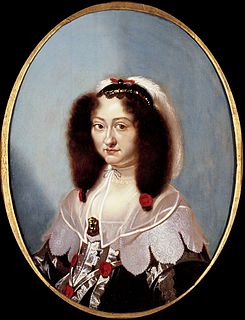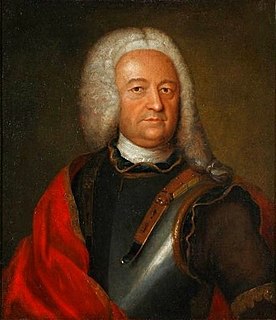Related Research Articles

Duchess Marie Elisabeth of Saxony was duchess consort of Holstein-Gottorp as the spouse of Duke Friedrich III of Holstein-Gottorp. As a widow, she became known as a patron of culture.

Duchess Anna Sophie of Saxe-Gotha-Altenburg was a princess of Saxe-Gotha-Altenburg and Duchess in Saxony by birth, and by marriage a Princess of Schwarzburg-Rudolstadt.

Anna Maria of Mecklenburg-Schwerin was a German noblewoman, a member of the House of Mecklenburg and by marriage Duchess of Saxe-Weissenfels.

Johann Georg I, Duke of Saxe-Eisenach.

Sophia Eleonore of Saxony was a duchess of Saxony by birth and the landgravine of Hesse-Darmstadt from 1627 to 1661 through her marriage to Landgrave George II. She was the eldest surviving child of John George I, Elector of Saxony, and Magdalene Sibylle of Prussia.

Augustus of Saxe-Weissenfels, was a Duke of Saxe-Weissenfels-Querfurt of the House of Wettin and administrator of the Archbishopric of Magdeburg.

Johann Adolf I, Duke of Saxe-Weissenfels, was a duke of Saxe-Weissenfels-Querfurt and member of the House of Wettin. He was the first son of Augustus, Duke of Saxe-Weissenfels, and his first wife, Anna Maria of Mecklenburg-Schwerin.

Christian, Duke of Saxe-Weissenfels, was a duke of Saxe-Weissenfels-Querfurt and member of the House of Wettin.

Magdalene Sibylle of Saxony, in Denmark known as Magdalena Sibylla, was the Princess of Denmark and Norway from 1634 to 1647 as the wife of Prince-Elect Christian of Denmark, and the Duchess consort of Saxe-Altenburg as the wife of Frederick Wilhelm II, Duke of Saxe-Altenburg.

Francis Charles of Saxe-Lauenburg was a prince of Saxe-Lauenburg and a general during the Thirty Years' War.

Erdmann II, Count von Promnitz was Lord of Żary and Trzebiel in Lower Lusatia, and Pszczyna in Upper Silesia.

Johanna Magdalena of Saxe-Altenburg was a member of the House of Wettin. She was a Duchess of Saxe-Altenburg by birth and by marriage a Duchess of Saxe-Weissenfels-Querfurt.

Magdalena Sibylle of Holstein-Gottorp was a Duchess of Holstein-Gottorp by birth and by marriage Duchess of Mecklenburg-Güstrow. From 1654 to 1695, she was the consort of Duke Gustav Adolph of Mecklenburg-Güstrow. She is also a direct line ancestor to Queen Victoria.

Caroline of Stolberg-Gedern was a Princess of Stolberg-Gerdern by birth and by marriage a princess of Hohenlohe-Langenburg.
Johannetta, Countess of Sayn-Wittgenstein-Sayn-Altenkirchen, was Sovereign Countess of Sayn-Wittgenstein-Sayn-Altenkirchen from 1648 to 1701. She was also Landgravine of Hesse-Braubach by marriage to John, Landgrave of Hesse-Braubach, and Duchess of Saxe-Marksuhl by marriage to John George I, Duke of Saxe-Eisenach.

Christine of Mecklenburg-Güstrow was a German noblewoman of the House of Mecklenburg and by marriage Countess of Stolberg-Gedern.
Johanna Walpurgis of Leiningen-Westerburg, was a German noblewoman member of the House of Runkel and by marriage Duchess of Saxe-Weissenfels.

Fredericka Elisabeth of Saxe-Eisenach, was a German noblewoman member of the House of Wettin and by marriage Duchess of Saxe-Weissenfels.
Sibylle is a given name. It may refer to:

Christine Johanna Emilie, Princess of Anhalt-Köthen was the second wife and consort of Augustus Louis, Prince of Anhalt-Köthen.